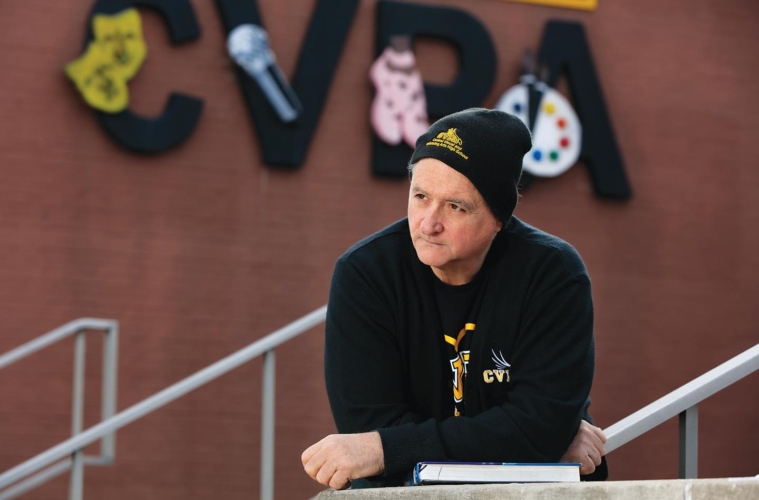When Mike DeFilippo ’78 heard about the 2018 school shooting in Parkland, Fla., he asked himself, “Am I prepared to take a bullet for kids?” Yes, he was, he decided.
DeFilippo is a substitute teacher at Central Visual and Performing Arts (CVPA) High School in St. Louis, Mo. He’s taught a variety of subjects in different classrooms for the past five years, and thus, has trained himself to have situational awareness. “Whenever I go into a room,” he says, “I always figure out, ‘How would I defend this room?’”
So on Oct. 24, 2022, when a 19-year-old entered the school with an AR-15–style rifle, DeFilippo had a plan. He was alerted when the principal announced, “Miles Davis is in the building” — the school’s code for an active shooter. A security guard came running down the hallway and told DeFilippo to get inside and lock the door. “Immediately, we heard sirens,” DeFilippo says.
They next heard shots. Boom. Boom. Boom. DeFilippo wheeled a SMART Board in front of the classroom’s door. As practiced, the students had moved to the back of the classroom; he flipped desks on their sides for the teens to hide behind. Meanwhile, DeFilippo grabbed a stand from a physics lab to use as a club.
Then they waited. Approximately 15 minutes later, there was a bang on the door and the police yelled, “Open up!” The teacher paused until he heard a different officer’s voice telling them to open the door. “I unlocked the door, and as soon as I did, the kids took off,” DeFilippo says. They were all escorted to a staging area, where investigators, counselors, and reporters stood ready.
“Some of the kids wrote me emails after, thanking me for keeping them safe,” he says. “Broke my heart.”
A teacher — who was one year from retirement — did have to take a bullet for her students that day. She died, as well as a 15-year-old student. Police killed the shooter, who was an alumnus.
Because the school was a crime scene, DeFilippo wasn’t allowed to drive his car home. A friend picked him up, and when he returned to his house around 1 p.m., he called loved ones to let them know he was safe. The rest of the day was a blur.
DeFilippo got into teaching after a career as a photojournalist and commercial studio photographer. The photography profession can be hard on the body, between lugging cumbersome gear and the long hours. “It’s a young person’s game,” he quips.
When DeFilippo switched to part-time photography, he started substitute teaching, which he finds “rewarding and challenging.” He has since retired from commercial photography and has embraced full-time teaching. This year he serves as the teacher of record (which includes the responsibility of awarding grades) for physics under a new program called Interim Learning Associate, designed to fill a teacher shortage after the pandemic.
The shooter had mental health problems, and his family had previously sent him for counseling. His mother discovered the gun in early October and called 911 to have the police take it away, but they said he was lawfully allowed to own the weapon. After the incident, some school officials and local lawmakers proposed the passing of a red flag law, which prevents the sale of and removes weapons from those deemed as a threat. DeFilippo sees the possibility as something good to come of the tragedy. “Let’s have a little sanity in America,” he says.
When the Columbine High School
shooting happened in 1999, DeFilippo
happened to be in the midst of a personal
project photographing cannons around the
country. Titled Local Ordnance, the series
came about when he was traveling for work
and noticed “everywhere there’s a cannon,
a tank, or some piece of ordnance in a
community,” he says. For example, during the
Cold War, America built an atomic cannon
that fires a nuclear shell. DeFilippo found
three of them, including one in Yuma, Ariz.,
“the largest land gun ever made.” Finding
“these different sub-stories” across the
country, “I had the whole map filled by 2013.”
He included it in his 30-year retrospective
show, which raised money for a local women’s
shelter. Following the St. Louis shooting last
year, “I started revisiting [Local Ordnance],
and I thought, ‘I guess I saw this coming.’
America’s a land of guns.”
CVPA closed for several weeks following the shooting and then switched to remote learning. During winter break, the school made repairs — patching bullet holes, fixing windows — and upgraded its security system. They returned to in-person learning in January: “Students and staff are on a wide spectrum in regard to their healing from the trauma,” DeFilippo says.
“Arming teachers is not a solution to the epidemic of gun violence gripping the nation,” he emphasizes. “I’m never going to carry a gun at work. Gun violence is a disease. You don’t stop a disease by spreading it.”

